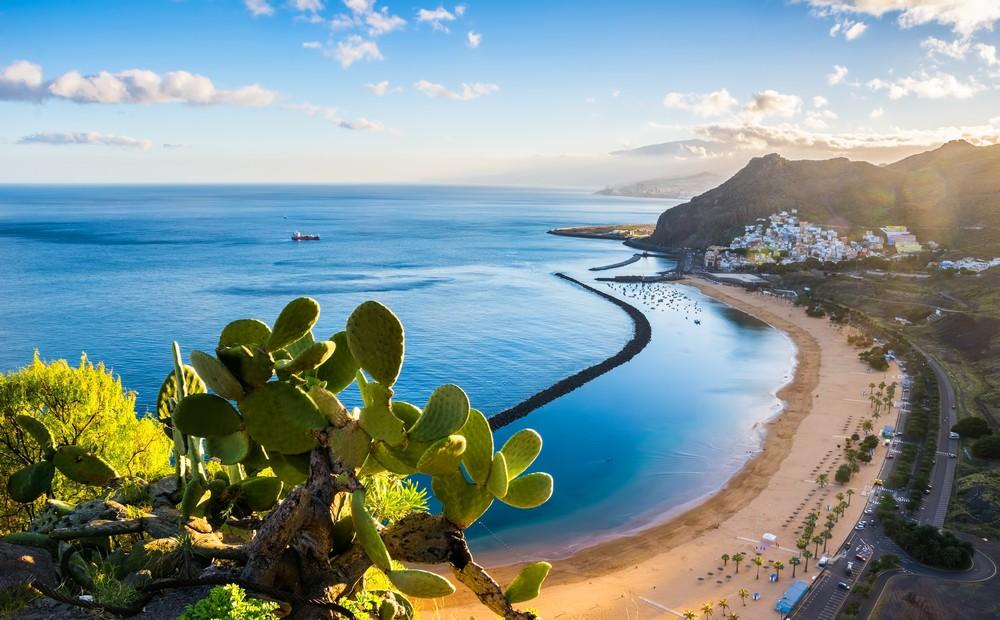Picturesque hills with laurel and pine forests, which alternate with a wildly romantic volcanic landscape, fantastic beaches, historical monuments and a diverse cuisine characterize the Canary Island of Tenerife. The most populous island in Spain attracts sun worshippers, families and active holidaymakers year after year. Party-goers get their money’s worth at Playa de las Americas, while history lovers walk in the footsteps of the indigenous people, the Guanches. Traditional towns with quaint pubs and narrow, flower-filled streets invite you to take a stroll, and in the hinterland the majestic Mount Teide rises.
Picturesque natural scenery and relaxed beaches
Tenerife is an island born of fire. Visitors can see this especially near the fishing village of Garachio. The interesting rock formations were created by a volcanic eruption in the 18th century and formed natural pools with deep blue water in which it is wonderful to swim. The most famous fire-breathing mountain on the island is the Teide volcano. It erupted for the last time in 1909 and is now located in a national park.
The summit of Mount Teide is above the clouds and is a popular destination for hiking – provided you wear warm clothing. There are also many beaches that bear witness to Tenerife’s volcanic past, including Playa El Bollullo with its fine, black sand. But white sand can also be found on the coast around the island. The crystal clear waters are suitable for diving, for example to the Tabaiba, a shipwreck that is now home to an impressive underwater world. In addition, whales and dolphins are at home in the waters off the coast.
If you want to admire idyllic lakes and waterfalls , you should take a boat trip to the island of La Gomera . Visitors can also see the small island from the Barranco de Masca mountain range with its majestic gorges. On the other hand, guests can experience adventures underground in the Cueva del Viento cave with its cooled lava lakes and bizarre rock formations. A special landmark of Tenerife is the thousand-year-old tree with its gnarled trunk. It is also called the dragon tree because, according to legend, it germinated from a drop of dragon’s blood.
Cultural sights and museums

Many peoples and cultures have left their mark on Tenerife , and holidaymakers can understand this by visiting the numerous historical monuments. Among the most interesting are the Pirámides de Güímar, stone pyramids that were discovered in the 90s and whose purpose scientists have still not sufficiently clarified.
The city of San Cristóbal has an old town worth seeing. Many buildings, including Laguna Cathedral, date back to the 16th and 18th centuries. Millions of guests make the pilgrimage to the Basílica de Nuestra Señora de Candelaria with its golden altar every year, and visitors marvel at ornate Renaissance buildings in the small town of La Orotava with its narrow streets. Next to it is the Jardín de aclimatación. The Botanical Garden is home to a variety of exotic plants that were originally stored for acclimatization and then brought to Spain.
In addition to historical monuments, visitors to Tenerife will find a number of interesting museums. The Tenerife Espacio de las Artes (https://teatenerife.es/) mainly exhibits contemporary artists. You can learn more about the geography and flora and fauna of Tenerife at the Museo de la Naturaleza y el Hombre. Here, visitors also learn everything they need to know about the cultural history of the original inhabitants. If you’re interested in space travel and astrology, head to the Museo de la Ciencia y el Cosmos, which houses interactive exhibits and a planetarium.
Modern attractions and culinary delights in Tenerife
Canarian cuisine is known for its hearty dishes such as meat stews, boiled potatoes and spicy paprika sausage. But fish, seafood and squid are also served here. Of course, a glass of red wine should not be missing. Fortunately, the dry climate and the many sunny days ensure that the vines thrive magnificently on the wine terraces.


